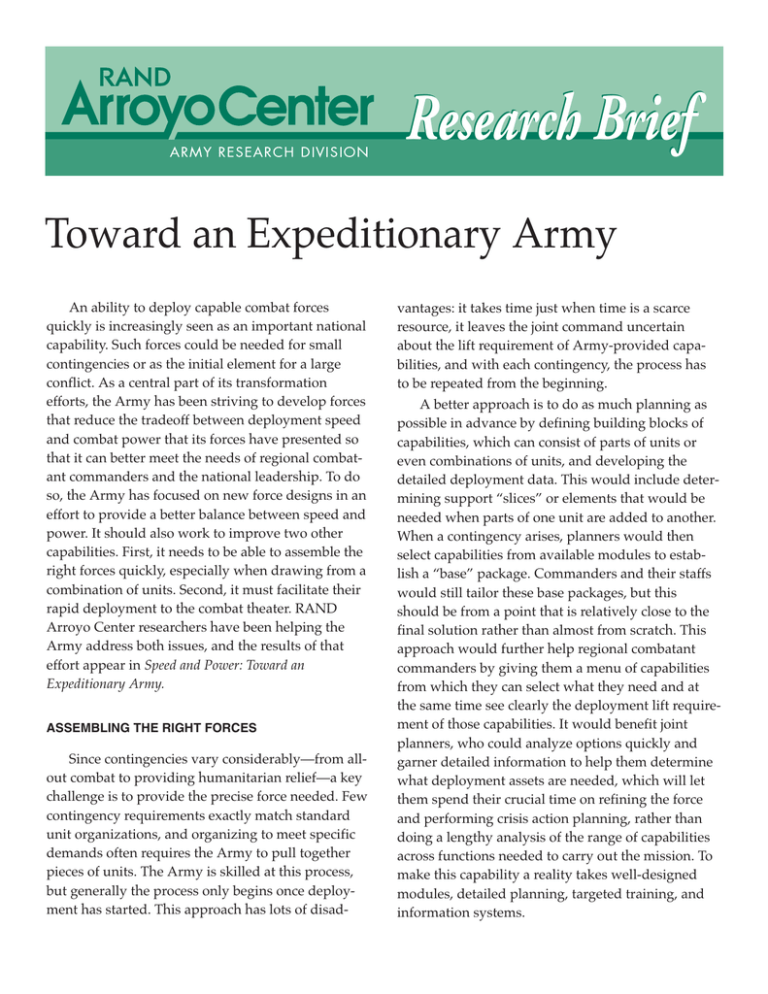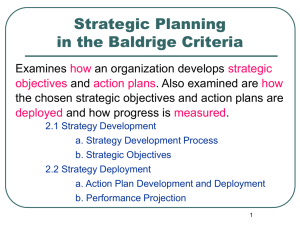Research B rief Toward an Expeditionary Army
advertisement

Research Brief Toward an Expeditionary Army An ability to deploy capable combat forces quickly is increasingly seen as an important national capability. Such forces could be needed for small contingencies or as the initial element for a large conflict. As a central part of its transformation efforts, the Army has been striving to develop forces that reduce the tradeoff between deployment speed and combat power that its forces have presented so that it can better meet the needs of regional combatant commanders and the national leadership. To do so, the Army has focused on new force designs in an effort to provide a better balance between speed and power. It should also work to improve two other capabilities. First, it needs to be able to assemble the right forces quickly, especially when drawing from a combination of units. Second, it must facilitate their rapid deployment to the combat theater. RAND Arroyo Center researchers have been helping the Army address both issues, and the results of that effort appear in Speed and Power: Toward an Expeditionary Army. ASSEMBLING THE RIGHT FORCES Since contingencies vary considerably—from allout combat to providing humanitarian relief—a key challenge is to provide the precise force needed. Few contingency requirements exactly match standard unit organizations, and organizing to meet specific demands often requires the Army to pull together pieces of units. The Army is skilled at this process, but generally the process only begins once deployment has started. This approach has lots of disad- vantages: it takes time just when time is a scarce resource, it leaves the joint command uncertain about the lift requirement of Army-provided capabilities, and with each contingency, the process has to be repeated from the beginning. A better approach is to do as much planning as possible in advance by defining building blocks of capabilities, which can consist of parts of units or even combinations of units, and developing the detailed deployment data. This would include determining support “slices” or elements that would be needed when parts of one unit are added to another. When a contingency arises, planners would then select capabilities from available modules to establish a “base” package. Commanders and their staffs would still tailor these base packages, but this should be from a point that is relatively close to the final solution rather than almost from scratch. This approach would further help regional combatant commanders by giving them a menu of capabilities from which they can select what they need and at the same time see clearly the deployment lift requirement of those capabilities. It would benefit joint planners, who could analyze options quickly and garner detailed information to help them determine what deployment assets are needed, which will let them spend their crucial time on refining the force and performing crisis action planning, rather than doing a lengthy analysis of the range of capabilities across functions needed to carry out the mission. To make this capability a reality takes well-designed modules, detailed planning, targeted training, and information systems. DEPLOYING THE FORCE RAPIDLY Stryker Brigade as Test Case To explore deployment issues, Arroyo Center researchers used a case study based upon a Stryker Brigade Combat Team (SBCT) hypothetically deploying from Fort Lewis, Washington, to Skopje, Macedonia, with two enroute bases. The Army is fielding the Stryker brigades as an interim step to the more capable Objective Force maneuver units. While the Stryker brigade lacks the firepower of heavy brigade combat teams (BCTs), it is considerably lighter than such units, and it has more firepower and mobility than do light forces. Techniques for Speeding Deployment When analyzing deployment speed, the amount of airlift and the capacity of airfield operations (runways, parking space, offloading capability, refueling capacity, etc.) are among many important assumptions. The Arroyo Center analysis does not assume a given amount of airlift; rather, it determines the maximum amount that could be used given the operational capacity of the airfields involved, which will vary depending on the mission. Also of note is that the analysis emphasizes deployment potential, that is, how fast a Stryker brigade can deploy when rapid deployment of ground forces is critical—not necessarily the “average” deployment speed. Airfield operational capacity is frequently the most constraining factor. Analysis of recent deployments indicates that U.S. forces will often deploy to airfields that can simultaneously handle only three or fewer C-17 aircraft, and sometimes even that capacity will not all be available to military forces because other organizations are using the same airfield. For example, during operations in Kosovo, aircraft moving U.S. forces had to share the airfield at Rinas with humanitarian flights. To identify opportunities to speed deployment, the analysis examines effects among the three dimensions of the deployment problem: deployment “footprint” or the amount of materiel that must be moved combined with the effectiveness of the aircraft loading, the location of the units or equipment, and the throughput of the deployment system. The analysis shows that a Stryker brigade loaded on the aircraft with reasonable effectiveness and using an airfield with a capacity of three C-17s could get to Skopje in 7.4 days, or just about twice as fast as a heavy BCT, and it would require 38 percent of the strategic airlift fleet projected for 2005. With its “medium”-weight combat vehicles, a Stryker brigade strikes a balance between deployment speed and power (see figure). Basing a unit or some part of its equipment in a forward location can speed things up considerably when availability of aircraft is the bottleneck. When airfield capacity is the limiting factor, forward basing still offers substantial benefits because it greatly reduces the number of aircraft required—deploying to Skopje from Germany requires only 8 percent of the 2005 airlift fleet to maximize the speed, a little under 7 days. Positioning complete sets of unit equipment forward can be quite expensive. But it is not necessary to preposition an entire Stryker brigade. Basing only trucks and some supplies overseas can lower the airlift requirement for deploying the brigade by 60 percent, yet these vehicles represent only 10 percent of the cost of a brigade’s equipment. Moving only Stryker combat vehicles by air could be done in four days from Fort Lewis to Skopje with 25 percent of the airlift fleet; if the 7.4-day response is acceptable, it could be done with 13 percent of the fleet. It is also possible to cut deployment time by boosting throughput. This can be done by finding ways to improve aircraft offload, clearing equipment from the airfield, and improving other elements of aircraft turnaround time. Actual aircraft turnaround times for initial unit deployments, especially with rolling stock, appear to be much lower than planning factors, e.g., an average of 45 minutes in Albania compared with the planning factor of 105 minutes, and during the Army’s first Stryker brigade air deployment exercise, aircraft turnaround times at the aerial port of debarkation averaged less than 30 minutes. Time improves with practice: the median aircraft turnaround time was only 27 minutes during the latter part of the operation. One reason for the difference is that planning factors aggregate different types of cargo and operational phases. 14 45% Forward unit positioning/ selected prepositioning CONUS: vary footprint Phasing Deployment time (days) 35% 10 Remainder of SBCT 30% 8 25% 6 20% 15% 4 10% 2 Airlift allocation (FY05 strategic lift fleet) 40% 12 5% 0% 0 CONUS– CONUS– heavy BCT SBCT, “light” loads CONUS– SBCT CONUS– SBCT, optimal loads CONUS– light BCT FWD– SBCT FWD– SBCT, 50% APOD time SBCT– Strykers only SBCT– Strykers only CONUS– SBnTF FWD– SBnTF Comparison of Deployment Times A complementary approach is to phase in a unit by carefully selecting modules that provide representative capabilities. Sending a combined arms battalion task force along with some additional modules as the initial element could provide the breadth (but not the depth) of SBCT capabilities. The goal is to get an initial capability in place as fast as possible. With this approach, a task force could get to Skopje from Fort Lewis in four days using 38 percent of the fleet, and only 8 percent if based in Germany. goal of 96 hours either from the United States or a forward base. But a forward-based unit can meet the goal using a much smaller allocation of aircraft. The figure summarizes the various deployment approaches discussed. The columns on the left show the effect of varying what has to be deployed while holding the percentage of the airlift fleet constant. The middle columns show the effect of positioning a unit or portions of its equipment forward. The columns on the right show the effect of phasing. Given the planning factors for departure airfields, a unit about the size of a light BCT or half that of a Stryker brigade can meet the Army’s deployment • Develop, with the Department of Defense, a global deployment strategy employing a mix of forward basing and selected prepositioning. RECOMMENDATIONS Arroyo Center researchers recommend that the Army: • Take a more capabilities-based approach to force deployment. • Develop detailed planning factors for rapid deployment units. • Work with the U.S. Transportation Command to improve outload and offload capabilities and practice techniques rigorously and frequently. RAND research briefs summarize research that has been more fully documented elsewhere. The research summarized in this brief was carried out in the RAND Arroyo Center; it is documented in Speed and Power: Toward an Expeditionary Army, by Eric Peltz, John M. Halliday, and Aimee Bower, MR-1755-A, 2003, 120 pp., $20.00, ISBN: 0-8330-3478-2, available from RAND Distribution Services (Telephone: toll free 877-584-8642; FAX: 310-451-6915; or Internet: order@rand.org). Abstracts of all RAND documents may be viewed on the World Wide Web (http://www.rand.org). Arroyo Center URL: http://www.rand.org/ard/. Publications are distributed to the trade by NBN. RAND® is a registered trademark. RAND is a nonprofit institution that helps improve policy and decisionmaking through research and analysis; its publications do not necessarily reflect the opinions or policies of its research sponsors. R 1700 Main Street, P.O. Box 2138, Santa Monica, California 90407-2138 • Telephone 310-393-0411 • FAX 310-393-4818 1200 South Hayes Street, Arlington, Virginia 22202-5050 • Telephone 703-413-1100 • FAX 703-413-8111 201 North Craig Street, Suite 202, Pittsburgh, PA 15213-1516 • Telephone 412-683-2300 • FAX 412-683-2800 RB-3041-A (2003)





